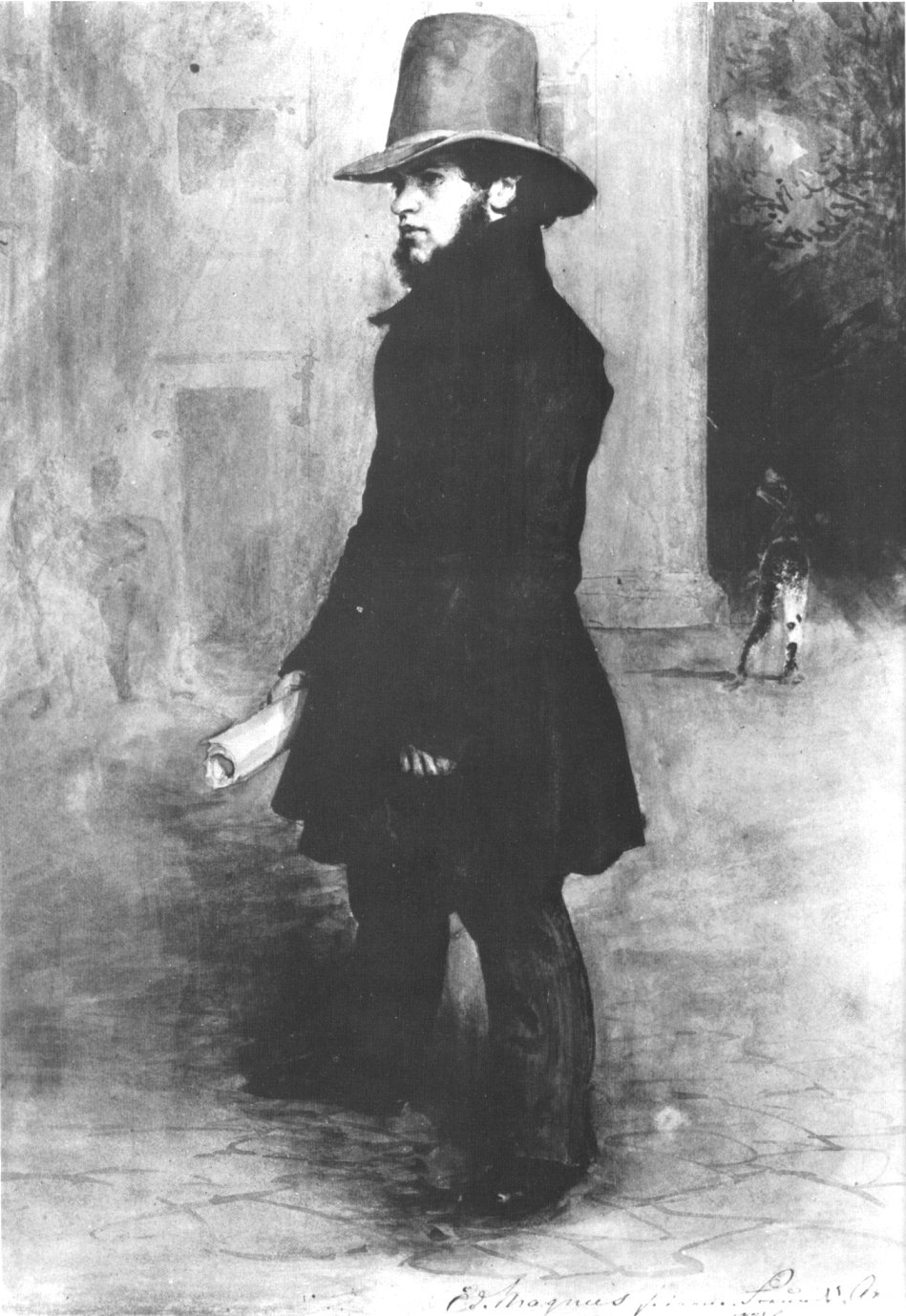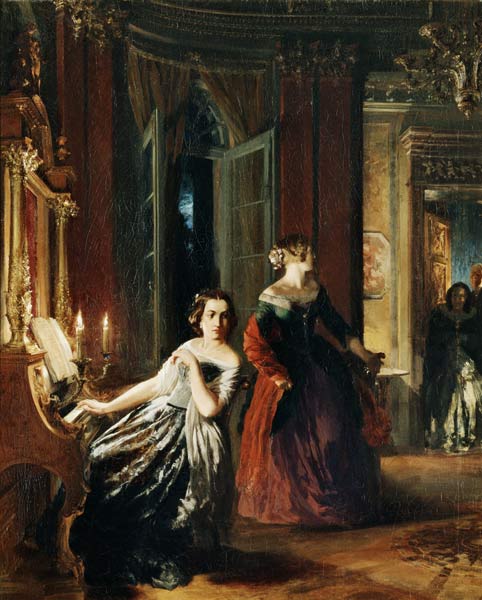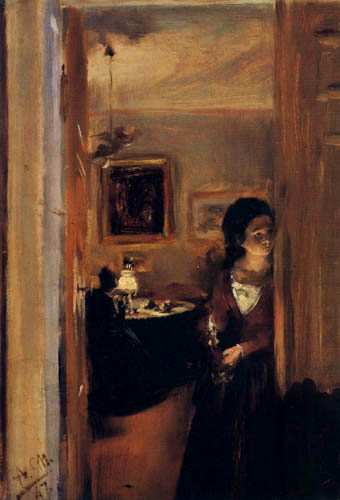I will start with the memories of Carl Johann Arnold, the son of Menzel's close friend and fosterer Carl Heinrich Arnold.
Carl Johann Arnold is one of the few art students that Menzel instructed personally and who himself became a painter.
 | |
| "Gallows Humor", 1873, Carl Johann Arnold |
Carl Johann Arnold
Memories
of my living together with Adolph Menzel, part I
With
the following I don't want nor can I follow the intention to deliver
a full biography of A.Menzel, of which there already have been
published a lot of encompassing ones and many will as well in future
times.
I
was lead to write down the below-mentioned to pass down some
interesting episodes from his starting time to the posterity to
redound to the characterization of his originality, there's
relatively little reported from those days, as well as to adjust some
exaggerations and falsehoods.
What
I am writing down here shall above all be given truthful, with no
frills and without own additions, only through this my notes might
presumably be of a special interest.
In
the Winter of 1833/34 my father met for the first time together with
Adolph Menzel during an evening drawing after nature, which was
organized by several Berlin artists. He pretty soon recognized him as
a very talented and most ingenious young man, who gained his whole
interest. After he had inquired on his financial circumstances he
found out that they were of the utmost modesty.
(…here follows a short
description of Menzel who's father had passed away and left him
caring for the daily bread for his mother and two siblings)...)
My
father then invited Menzel to visit him and to advice him with words
and deeds and as well to introduce him to influential persons who
might be of use to him. At that time we were living at Monbijouplatz
10 I., where father used to have a big factory for wallpapers.
At
our home it was always an agile and sociably coming and going which,
as I presume, attracted Menzel very much and he thus became a common
and always welcomed visitor.
Especially
on sundays, in the evening, when many of the then best artists and
other important persons as Eduard Magnus, Schinkel, Rauch, sculptor
Drake, Eduard Meyerheim, Prof. Hotho, General von Radowitz and others
would gather, where then a lot of music was played and the mood was
bright and harmless. In this circle Menzel was now introduced and
could make new connections and acquaintances. My father did as well
have a rich collection of drawings, copper engravings and etchings,
among others drawings of the Russian painter von Reutern, which
Menzel could study now – and of which he did many a copy. -
(…)
My father induced Menzel, who had only been drawing up
to that point, to study oil painting and taught him the first
handling of the technique, for he had studied two years in Paris
under David and was pretty skilled himself. Menzel copied now as a
start the self-portrait of Frans Hals, a broadly painted and because
of that greatly suited picture, which agonised Menzel very much and
it became very hard for him to stick with it. He was painting in a
backroom of our living room, which was set up for him to paint, but
whenever it was possible he preferred to talk to my mother or my
sisters. (…Arnold describes how he once got blue (Prussian blue)
paint in his beard, didn’t get it off and because of that had to
shave his beard off and didn’t come painting for over two weeks,
after that Menzel firstly was shagged off from oil painting and then
pretty caught up with his commissions on Goethe’s “Künstlers
Erdenwallen”, the “five senses” and others...)
Although
the situation of Menzel had much improved within three years he still
had to strive hard and had to work long till in the early morning
hours. Now a sudden change took place that my father had to settle to
Kassel to take over the wallpaper factory of my Grandfather, a turn
that Menzel very much regretted, as his letters vitally described. He
was dedicating a beautifully and deeply sensed inked drawing to us,
depicting the lamenting Berolina, sitting on a Lotosflower,
surrounded by singing children and a choir while angels are sending
cloudbursts from heaven’s gates.
(…)
Now
there’s a longer gap to my memories. I remember that my father had
a vivid written correspondence with Menzel* but as a child of seven
years I didn’t give too much attention to it.
(…)
I
remember the great joy we had when two pictures arrived from Berlin
which were Adolph Menzel, painted by Magnus, and Magnus drawn by
Menzel, both as whole figures in a small format.
 | |
| the painter Eduard Magnus drawn by Adolph Menzel (1841) |
 | |
| the young Adolph Menzel painted by Eduard Magnus (1841) |
As a joyous surprise Menzel came in 1841 to visit us in
Kassel which he didn’t know up to that point. Because I then was a
boy of twelve years I was able to show him the surrounding and all
sights of the town. The beautiful Wilhelmshöh with the
Habichts-forest, where we watched wild game in the evenings, then we
did make wanderings to Wilhelmsthal, an excellently conserved little
castle from the rococo, which fascinated him overly. The greatest
attraction of course was the Kassel painting gallery.
During this time he did some portrait drawings in
pencil. Unfortunately he couldn't extend his staying with us over a
span of several weeks, for in Berlin there were already new
commissions and projects waiting for him, above all the famous work
on Frederic II with the text by Franz Kugler. (…)
In
the year of 1843 my sister visited family Menzel, on this occasion
the outstanding portrait of her came into being, a lifesized
Kniestück.
At the same time I started to deal with painting for myself and
thus Menzel dedicated more time towards me and my progress.
We had to send him a lot of studies and works by me,
until he proposed to my father in 1846 to send me to him to Berlin,
where I then stayed for three months and had to work diligently. He
praised very little and was very hard in his criticism. We worked
till late at night and thus I was oftimes close to starving and was
wishing with great desire for supper. But when his sister, while she
was calling us repeatedly to come to table, was standing in an
interesting lightsituation there was firstly made a study after her,
which again took a longer while.
This intensive working time was all of a sudden
interrupted by the abrupt illness of Menzel's mother, followed after
a short time by her death. Menzel was connected to his mother in
deepest love and admiration and this stroke of fate got very hard on
him.
In these sad days of course I couldn't stay with the
Menzel's and was heartily accommodated at Professor Fritz Drake's
place. To deflect them from those sad moods a bit I was quartered
back after eight days, where then after a while and bit by bit a more
quiet and somewhat bright atmosphere came into being. In this time of
my staying with him Menzel was without intermission working on the
illustrations of the works of Frederic II and the illustrations of his army.
Although he did work hard during the whole day it didn't bother him
to stay up late and read throughout half of the night.
One time he found a long expected book on Frederic the
Great waiting for him in which he deepened so much that he didn't
take off his hat and Paletot, reading until the morning dawned.
He
came into the sleeping room when I woke up in the morning. On
Christmas I returned home.
The
oilpainting “Die Störung” was exhibited for the first time ((at the) Academy).
 |
| Adolph Menzel, "the disturbance" |
To study the
candle light accurately he had constructed a tiny parlour with a
small piano and two little lights and as well a tiny dressed puppet.
He already begun the painting in 1843, on the first sketch a young
lady is walking up and down in the room, later he changed his idea
into an unexpected visit in the background. (…)
*the
main body of Menzel’s letters from the 1830’s/40’s is between
Arnold and Menzel.


Thank you for translating this important first-hand account, Christian. It's fascinating to see Menzel's early progress up close. He was figuring out how to paint in his own way, and his originality and mastery issued from his independence.
AntwortenLöschenThanks, James :-)
AntwortenLöschen